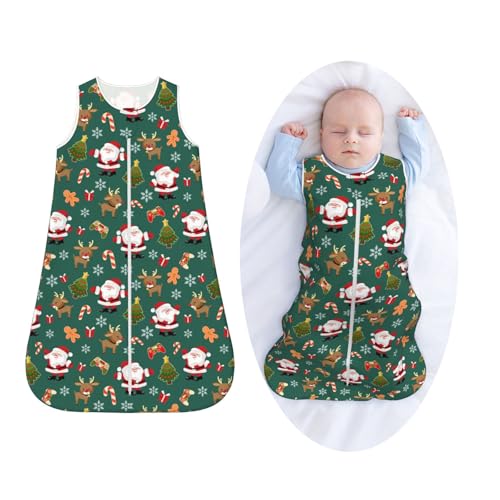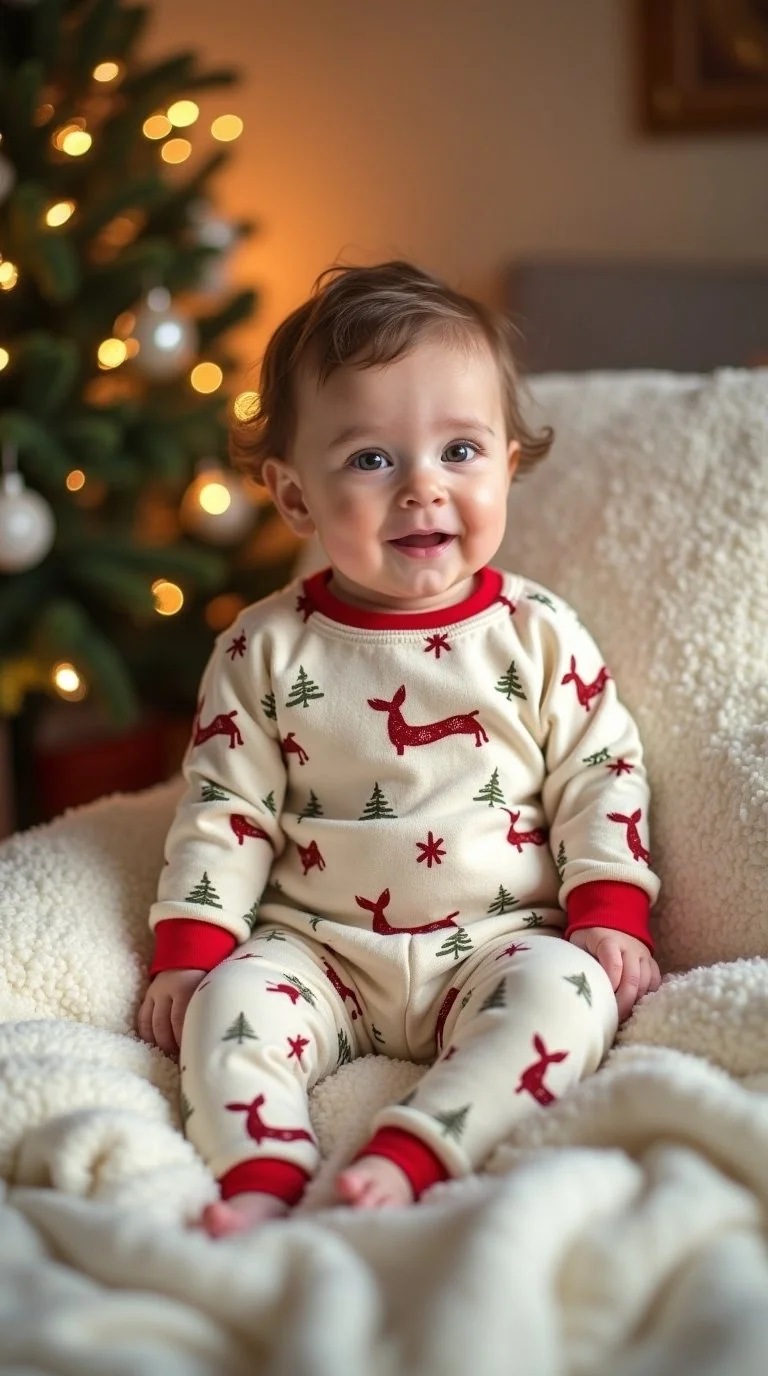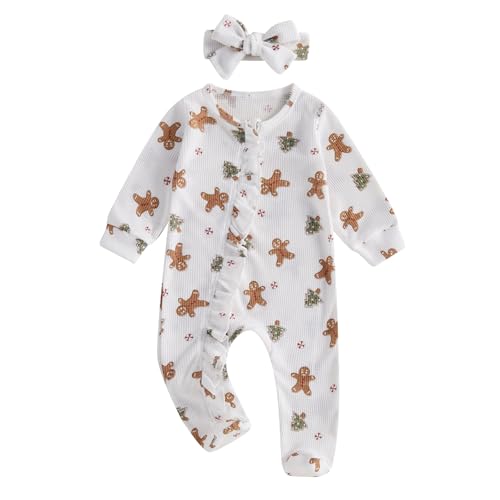Best Christmas Pajamas for Infants
There's something magical about seeing your baby in festive Christmas pajamas for the first time. As a mom of 5, I know choosing the right pajamas matters—whether for holiday photos or cozy December nights. Did you know nearly 8 in 10 parents say it’s important to share the holiday traditions they grew up with — from baking cookies to matching family pajamas.
Not all infant Christmas pajamas are equal. After dressing five babies through countless holidays, I've learned what matters: safety, comfort, and gentle fabrics for sensitive skin.
From flame-resistant materials to easy diaper-change access (you'll thank me at 2 AM), I'm sharing everything to find the best Christmas pajamas infants can wear comfortably all season.
And if you're preparing for baby's arrival, don't miss my complete baby registry checklist and newborn sleep tips to make those early months easier.
For more ways to celebrate the season with your little ones, check out these Christmas crafts for kids. Let's make this holiday season extra special (and extra adorable).
This post may have affiliate links, which means I may receive commissions if you choose to purchase through links I provide (at no extra cost to you). As an Amazon Associate, I earn from qualifying purchases. Read more about these links in my disclaimer policy.
What Makes BEST Christmas Pajamas for Infants?
When shopping for Christmas pajamas, it's important to look past those adorable reindeer prints and focus on what actually matters for your little one's safety and comfort.
Safety features should be your number one priority. The Consumer Product Safety Commission (CPSC) has specific guidelines for infant sleepwear, and you want pajamas that either meet flame-resistant standards or are snug-fitting enough to pass safety requirements. Snug-fitting pajamas work because there's less fabric to catch fire in the unlikely event of an emergency. While it's not pleasant to think about, it's an important consideration.
The material is where you'll see the biggest difference in quality. Organic cotton is excellent for babies with sensitive skin—it's breathable, hypoallergenic, and gets softer with every wash. Bamboo fabric is another strong option because it naturally regulates temperature, so your baby won't get too hot or too cold during the night.
Here's what to look for when shopping for infant Christmas sleepwear:
Soft, breathable fabrics like 100% organic cotton, bamboo, or cotton-spandex blends
Easy diaper access with snap closures, two-way zippers, or elastic waistbands (because nobody wants to fully undress a crying baby at 3 AM)
Non-toxic dyes and chemical-free materials
Proper sizing that accounts for rapid infant growth spurts
Secure stitching with no loose buttons or decorative elements that could become choking hazards
Durability for multiple washes throughout December
Temperature regulation is an often-overlooked factor. You don't want your baby overheating in heavy fleece pajamas if your house is already warm. On the flip side, thin cotton might not provide enough warmth if you keep the thermostat low at night. Finding that balance is key to good sleep for everyone.
And let's address sizing: babies grow remarkably fast during those first months. If you're buying Christmas pajamas in October for use in December, definitely size up. Many parents have learned this lesson after purchasing adorable pajamas that their baby outgrew after just one or two wears.
Top Types of Christmas Pajamas for Infants
There are many options available, and each style has its own advantages and considerations. Here's what you should know about each type of infant Christmas pajama.
Footed sleepers are an excellent choice for cold winter nights. These one-piece designs keep your baby warm from neck to toes without any loose socks falling off during sleep. The all-in-one design means no riding up, no exposed belly, and no lost socks in the crib. Just make sure the foot part isn't too large—you want them snug enough that baby won't trip once they start cruising around furniture.
Sleep gowns with mittens are perfect for newborns and young infants. The gown style makes diaper changes remarkably easy because you just pull it up instead of dealing with snaps or zippers. The fold-over mittens keep those tiny fingernails from scratching baby's face. However, once your baby starts rolling and moving around more, these become less practical.
Two-piece Christmas pajama sets offer the most flexibility. You can mix and match tops and bottoms, layer them if needed, and they're easier to adjust if one piece gets dirty. The snap-button tops and elastic-waist bottoms make diaper changes straightforward. These work well for warmer climates or for babies who run hot at night.
Zipper rompers with two-way zippers are particularly convenient for middle-of-the-night changes. You zip from the bottom up for diaper access without removing the whole garment. No struggling with snaps in the dark. These are an excellent recommendation for new parents who are still figuring out the nighttime routine.
Sleep sacks with festive Christmas designs are great if you're following safe sleep guidelines strictly. They replace loose blankets while keeping baby warm and cozy. Look for ones with shoulder snaps for easy on and off. The main consideration is that they can be pricey, and babies outgrow them relatively quickly.
Bodysuits and onesies are perfect for:
Warmer climates where heavy pajamas would be too much
Layering under other clothing for extra warmth
Quick changes when you're out and about during the holidays
Babies who tend to overheat easily at night
Matching family sets have become increasingly popular in recent years. There's something special about coordinating Christmas pajamas for the whole family in holiday photos. Just be prepared—the baby sizes usually sell out first, so order early if you're planning matching family pajamas.
Best Materials for Infant Christmas Pajamas
The material of your baby's pajamas matters significantly for comfort and safety. Here's what you need to know about the most common options.
100% organic cotton is an excellent choice for most babies. It's breathable, which helps prevent overheating during sleep. It's hypoallergenic, making it ideal for sensitive skin or babies prone to eczema. And it actually gets softer with each wash. The main consideration is that organic cotton pajamas tend to be pricier, but many parents find them worth the investment for comfort and peace of mind.
Bamboo fabric is worth considering for its unique properties. It naturally regulates temperature better than cotton, pulling moisture away from baby's skin. It's incredibly soft and naturally antimicrobial, which is beneficial for baby clothes that experience frequent spills and accidents.
Cotton-spandex blends offer stretchy comfort that moves with active babies. If your little one is rolling, crawling, or starting to pull up, these blends allow for more movement without restriction. They typically contain about 95% cotton and 5% spandex, giving you the breathability of cotton with added flexibility. Just make sure the percentage of synthetic material is low.
Microfleece is warm and cozy without being overly bulky or heavy. It's lighter than traditional fleece but still provides good insulation for cold nights. Microfleece Christmas pajamas work well for layering or for babies who need extra warmth. Just be careful not to overdress—you can always add layers, but an overheated baby is difficult to cool down.
Jersey knit is that classic t-shirt material that's soft, durable, and maintains its shape after multiple washes. It's a solid middle-ground option that works for most babies and most temperatures. Not too hot, not too cold. Jersey knit Christmas pajamas are usually affordable as well.
Here are materials to avoid:
Heavy synthetic polyester that doesn't breathe
Rough textures or stiff fabrics
Anything with sequins, buttons, or embellishments that could come off
Fabrics treated with harsh chemicals (always check the label)
Understanding flame-resistant vs. snug-fitting: Flame-resistant pajamas are chemically treated to slow down burning. Snug-fitting pajamas achieve safety through their tight fit—less fabric means less material that could catch fire. For infants, many parents prefer snug-fitting organic cotton to avoid chemical treatments, but both options meet federal safety standards. It's ultimately about what makes you comfortable as a parent.
Adorable Christmas Pajama Styles and Themes for Babies
Once you've established safety and comfort priorities, it's time to choose the design. There are many delightful options available.
Classic Santa Claus designs never go out of style. Red and white color schemes, little Santa hats printed on the fabric, "Santa's Little Helper" text—these are timeless choices. They can be used year after year if you save them for future children or pass them down. They also photograph beautifully, especially against a Christmas tree background.
Reindeer patterns are perennially popular. Rudolph with his red nose, all the reindeer friends lined up—it's festive without being overwhelming. Some designs feature little antlers on the hood, which are particularly charming. Just note that 3D antlers can be uncomfortable if baby tries to sleep on their back.
Snowman motifs work perfectly if you're going for a winter wonderland theme in your photos. They're cheerful and festive, but not specifically Christmas-focused, so you can use them beyond December if desired. The white, orange, and black color scheme is also easy to coordinate with other outfits.
Gingerbread cookie prints are sweet and whimsical. Little gingerbread men, candy canes, and cookies scattered across the fabric create an adorable look. These tend to be popular for baby's first Christmas because they're cute without being too babyish.
"Baby's First Christmas" commemorative designs are special milestone pieces. These pajamas usually have the year printed on them, making them perfect keepsakes. Many parents save their children's first Christmas pajamas as mementos. Just remember these are specific to that one year, so they're more about creating a memory than repeated use.
Other popular styles include:
Plaid and buffalo check patterns for a cozy cabin aesthetic
Elf-inspired green and red striped designs
Snowflake and winter scene illustrations
Christmas tree and ornament patterns in various color combinations
Neutral and minimalist holiday designs for a more subtle approach
Neutral and modern minimalist designs have become increasingly popular. Think cream-colored pajamas with tiny green trees, or gray sets with simple snowflake patterns. These are excellent if you want something festive but more understated for photos. They also coordinate better with various home decor styles.
One tip: consider your photo background when selecting patterns. If you're taking pictures by a colorful Christmas tree, simpler pajamas often photograph better. If the background is plain, busier prints work well.
Size Guide: Choosing the Right Fit for Your Infant
Sizing is one of the trickier aspects of buying infant Christmas pajamas, especially when shopping online. Babies grow at different rates, and brands size their clothes inconsistently.
Understanding infant size ranges is your starting point. Most brands break it down like this: newborn (up to 8 pounds), 0-3 months (8-12 pounds), 3-6 months (12-16 pounds), 6-9 months (16-20 pounds), and 9-12 months (20-24 pounds). However, these are guidelines. Some babies wear 6-9 month clothes at 4 months old, while others fit perfectly into age-appropriate sizing.
When to size up: If you're buying Christmas pajamas in October or November for use in December, consider going up one size. Your baby will likely grow significantly between when you order and when you use them. Plus, slightly larger pajamas will last longer throughout the holiday season and beyond.
Growth charts can be helpful, but they're not definitive. Check your baby's weight and length against the brand's specific size chart before ordering. The term "3-6 months" doesn't mean the same thing across all brands. Some run small, some run large, and some are right on target with average sizing.
Brand-specific sizing considerations: Carter's tends to run true to size. Old Navy runs slightly large, which works well for sleepwear. Hanna Andersson runs small and uses European sizing, so carefully check their charts. Target's Cat & Jack brand is generally consistent and true to size.
Snug-fit versus loose-fit requirements: For safety, infant sleepwear should be snug-fitting unless it's flame-resistant. Snug-fitting means they should fit close to the body without being uncomfortably tight. This reduces fire hazard because there's less fabric that could catch flame. Loose-fitting pajamas are appropriate only if they're labeled as flame-resistant.
Tips for measuring your baby correctly:
Measure length from shoulder to toe while baby is lying flat
Measure around the fullest part of the chest
For two-piece sets, measure waist circumference
Compare these measurements to the brand's size chart, not just age recommendations
When in doubt, size up for pajamas—better too big than too small
For cloth diaper users: If your baby wears cloth diapers, you'll need extra room in the diaper area. Cloth diapers add significant bulk that most pajamas don't account for. Snug-fitting pajamas may be too tight to snap over a cloth diaper. For cloth diaper babies, consider sizing up or looking for styles with extra room in the seat, like two-piece sets or looser rompers.
Return and exchange policies are important when buying infant Christmas pajamas online. Always check before you purchase. Some retailers have generous return windows, while others have strict no-return policies on holiday items. Save your receipts and packaging until you're sure the size works.
Budget-Friendly Options vs. Premium Christmas Pajamas
Christmas pajamas range from very affordable to quite expensive. Understanding what you're paying for helps you decide where to invest and where to save.
Price ranges vary dramatically. You can find basic infant Christmas pajamas at Walmart for $8-10. Mid-range options at Target or Old Navy run $12-20. Premium organic brands like Hanna Andersson or Burt's Bees Baby go for $25-40+. Luxury designer baby pajamas can reach $50-60.
When is it worth investing in higher quality? It depends on your priorities. If you want keepsakes, if baby has sensitive skin, if you're planning to use them for multiple children, or if you're doing professional photos—then investing makes sense. If you just need something cute for Christmas morning, budget options work perfectly well.
Multi-pack deals can stretch your budget. Carter's often offers 2-packs or 3-packs of holiday pajamas at a discount. You're getting multiple pairs for slightly more than the cost of one premium pair. This is practical if you want backups or if you'll be using Christmas pajamas throughout December as regular sleepwear.
Sales timing matters. The best time to find deals on Christmas pajamas is September through November, especially around Black Friday. Many retailers clearance remaining holiday items in late December and January, though selection is limited by then. Early October typically offers the best selection at regular prices, with additional deals during Black Friday sales.
Quality indicators that justify higher prices:
Organic cotton or bamboo fabric instead of polyester blends
Reinforced stitching at stress points
Quality zippers (like YKK) that don't snag
Durable snaps that stay fastened
Substantial fabric weight that suggests longevity
Brand reputation for holding up through multiple washes
Store brands with strong value include Target's Cat & Jack and Costco's Kirkland Signature baby clothes. These offer organic cotton and thoughtful design at lower prices. Some of these budget-friendly options hold up through multiple children.
Cost-per-wear analysis: If you buy $30 pajamas that baby wears 20 times throughout December and January, that's $1.50 per wear. If you buy $8 pajamas that baby wears twice for photos, that's $4 per wear. Sometimes the more expensive option provides better value if it gets more use.
Secondhand options are worth considering for baby clothes. Babies grow so quickly that most Christmas pajamas are barely worn before being outgrown. Check Facebook Marketplace, Poshmark, ThredUp, or local consignment shops. You can often find high-quality brands at significant discounts. Just inspect carefully for any damage, washing issues, or excessive wear that could affect safety.
Frequently Asked Questions
What size Christmas pajamas should I buy for my 3-month-old?
Buy 3-6 months if shopping near Christmas. For early shopping or extended wear, size up to 6-9 months. Check brand size charts for weight/length. Slightly large works better than too snug—roll sleeves temporarily if needed.
Can my baby wear Christmas pajamas every night or just for photos?
Absolutely! Quality cotton or bamboo pajamas meeting safe sleep guidelines work for nightly wear throughout December and beyond. Rotate several pairs for full seasonal use.
What's the difference between flame-resistant and snug-fitting pajamas?
Flame-resistant pajamas are chemically treated; snug-fitting achieve safety through tight fit. Both meet CPSC standards. Many parents prefer snug-fitting organic cotton to avoid chemical treatments, especially for sensitive skin.
When should I start shopping for infant Christmas pajamas?
September or early October for best selection. Popular styles sell out by mid-November. Late November/December offers clearance deals but limited choices.
How many pairs of Christmas pajamas does my infant need?
2-3 pairs ideal (wear, wash, backup). One special pair for photos works for budget-conscious families. Extra pair helpful for travel or celebrations.
Can newborns wear Christmas pajamas, or should I wait?
Newborns can wear them! Choose newborn/0-3 months with easy diaper access (gowns, snap-fronts, two-way zippers). Use soft fabric and follow safe sleep guidelines.
Final Thoughts
Finding the perfect Christmas pajamas for your infant is simple when you prioritize safety, soft breathable materials, and easy diaper access. Whether choosing classic Santa designs, cozy footies, or matching family sets, focus on what works for your family and budget.
Start shopping early—October is ideal for the best selection, especially for matching sets since infant sizes sell out quickly. Measure your baby carefully and order from trusted retailers.
These festive pajamas create precious holiday memories and adorable photos you'll treasure forever. Even imperfect moments—like last-minute spit-up—become cherished memories. Happy holidays, and enjoy every cozy moment with your little one!







